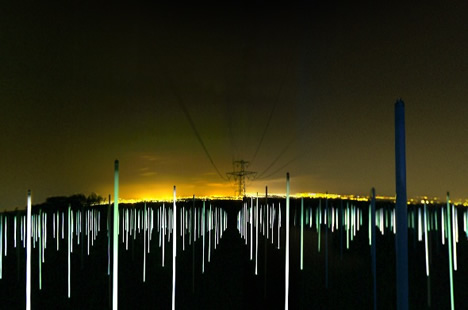Above are images of 1301 flourescent tubes powered only by the electric fields generated by overhead powerlines. |
By Brian Addison
Investigative Reporter
Eastern Oregon – Concerned citizens in northeastern Oregon are organizing to stand up and protect their property rights, and currently there are two major land-use battles being waged in the region. Local citizens groups have won a recent fight against the intrusion of a 500-kilo-volt (kV) electrical transmission-line proposed on a route through valuable agricultural lands and across scenic vistas in southwestern Idaho and northeastern Oregon. This latest local victory can be attributed to a group of citizens who were able to engage their political representatives in Salem, who then went to work protecting the interests of their constituents.
While citizen groups in eastern Oregon have had success by delaying decisions on the transmission-line route, on another front local citizens continue to struggle against the national Travel Management Plan, and face the closure of thousands of miles of roads and the loss of motorized access to the local forest lands. Over 6,500 residents of the Wallowa-Whitman region have signed a petition to protest and local opposition measures 32 to 1 against the new travel regulations being proposed by the United States Forest Service (USFS) for the Wallowa-Whitman National Forest (WWNF).
Local residents have made progress in getting Idaho Power to reroute the 500-kV transmission-line away from valuable interests and they’ve done this by gaining the support of their political representatives. The question then becomes, why haven’t the political representatives reacted in the same manner to protect local interests from the USFS Travel Management Plan proposal? There has been an organized effort of protest from over 6,500 registered voters (which is about 10-percent of the total population of the region) against the proposed travel plan, and still their elected representatives support the cooperative relationship between the USFS and the counties of northeastern Oregon, and access to the public lands of the WWNF is in jeopardy.
Citizens Successfully Delay 500-kV Transmission Line Project
Idaho Power Company has proposed construction of a 500-kilo-volt (kV) electrical transmission line covering a 300-mile route from Owyhee County in southwest Idaho to the town of Boardman in northeastern Oregon, referred to as the B2H project.
A public outcry from the agricultural community and property owners along the proposed path of the transmission-line quickly materialized into the organization of citizen protest groups who then gained the support of their local political representatives in Salem. With the help of their political representatives, the citizens have successfully delayed the B2H project, forcing Idaho Power to consider alternative routes for the 500-kV line.
“If anything is clear, it is that Idaho Power has badly underestimated the passion with which families will fight to protect their farms and ranches against the intrusion of Oregon’s first 500-kV transmission line crossing exclusive farm use lands,” stated Oregon Senate Republican Leader Ted Ferrioli after a recent congressional meeting on the Idaho Power B2H project.
Oregon Representative Cliff Bentz (R) and agricultural aerial applicators worry that the 180-foot towers constructed for the B2H project would curtail aerial spraying on some of the richest agricultural lands in the state. Bentz offered an amendment to current House Bill 3153 at the April 9th meeting of the state Sustainability and Economic Development Committee that looks to limit the construction of electrical transmission-lines to a height of 50-feet on land zoned for exclusive farm-use to protect the practice of agricultural aerial spraying, and reaffirms the jurisdiction of county government in local land use decisions.
On the other side of the table, the utility industry referred to the proposed 50-foot height limitation on electric transmission lines as a “prohibition” on projects such as the Idaho Power B2H project.
Irrigation districts are concerned over the proposed route because the transmission-line would impact about 130,000 acres of irrigated farm land in Malhuer and Baker Counties. “The route runs right down the middle of our irrigation district and would devastate agriculture in the Durkee valley,” according to President of the Burnt River Irrigation District Jerry Franke.
Rep. Bentz was joined in Salem on April 9th by about 30 members of the citizens’ organization Stop Idaho Power who made the trip from eastern Oregon for the opportunity to give testimony against Idaho Power’s proposed route. Property owners and members from the agriculture, tourism, real-estate and energy industries testified in front of the Sustainability and Economic Development Committee.
The very next day, April 10th, in an apparent victory for the citizen groups, Idaho Power attorneys sent a letter and cancelled a scheduled hearing with the Oregon Public Utilities Commission, where they were to give testimony on the need for the 500kV line. The letter also indicates that Idaho Power now plans to form a relationship with stakeholders to try and develop an acceptable route for the 500-kV line.
Idaho Power’s original proposed route for the 300-mile long transmission fell on 88-percent private land and 11-percent public lands. “It’s not only about the view shed, the alleged health affects or even the threat of condemnation that galls, it is the knowledge that Idaho Power analyzed alternatives and concluded that it would be easier to roll over ordinary citizens than to confront environmental groups who will likely litigate any route involving public lands,” concluded Sen. Ferrioli after the committee meeting.
While the B2H project now faces what Idaho Power refers to as a “pause”, the Bureau of Land Management (BLM) continues to work on a Memorandum of Understanding, seeking to form a cooperative relationship with 15 entities including several counties, during the completion of an Environmental Impact Statement for Idaho Power’s B2H project. According to a recent report in the La Grande Observer, Union County Commissioners have already been authorized to sign the cooperative agreement with the BLM on the advice from Union County Planner Hanley Jenkins, even though the BLM claims the document is not yet available to the public.
Residents of NE Oregon Continue Fight USFS Travel Management Plan
There are about 6,500 people here in eastern Oregon who wrote letters of protest and signed petitions against the USFS Travel Management Plan proposal in the Wallowa-Whitman National Forest (WWNF). Some of these 6,500 people are now wondering how to get their political representatives to stand up and protect local interests in a manner similar to that just witnessed in the Idaho Power B2H project. Rather, their political representatives on every level are cooperating with or have remained mostly silent on the USFS travel management proposal, which threatens the loss of thousands of miles of forest roads and the loss of public access to the WWNF.
Commissioners from the five counties of northeastern Oregon disregarded the outcry from their constituents and signed an agreement to cooperate with the USFS during the Travel Management Plan. The agreement combines five counties into one “cooperating agency”, and names the USFS as the “lead agency” for the expected two-year duration of the Travel Management Plan project.
Not long after signing the cooperative agreement, Baker and Union County Commissioners were asked, “Given the Forest Service proposal to remove 4,261 miles of forest roads and then close everything else in the Wallowa-Whitman National Forest, can the Commissioners from this county really claim they are ‘cooperating’ with the Forest Service?” Not one of the six Commissioners chose to answer that question.
In September, 2008 a team of 25 USFS employees began the Travel Management Plan work sessions. The USFS has released no information about the Travel Management Plan since the work sessions began and have recently denied a public record request for the draft Environmental Impact Statement being prepared for the project.
Under the cooperative agreement Baker, Union, Umatilla, Grant and Wallowa Counties were allowed to assign one person, Bob Messinger of Summerville, to attend the USFS Travel Management Plan work sessions. Messinger attended the USFS work sessions but he is unable to share any information about the Travel Management Plan project with the public because the county commissioners from the five counties signed a confidentiality agreement with the USFS before the work sessions began.
The USFS gives this June 16 as the date for release of the draft Environmental Impact Statement for the Travel Management Plan project in the WWNF and this is when the public will see the access plan for the mountain locations that are important to them. In reality though, forest-users in the WWNF are already seeing roads closed under a variety of federal land management guidelines. USFS officials have assured the public that access to private property for any legal use would be protected, but there are beginning to be reports of miners being shut-out of their claims by federal road closures.
When watching these federal road closures remember the words of Sen. Ferrioli quoted above on the proposed route of the 500-kV line, when he said that Idaho Power had “analyzed alternatives and concluded it would be easier to roll over ordinary citizens than to confront environmental groups who will likely litigate any route involving public lands.” Those words can be applied to the Travel Management Plan but instead of Idaho Power it is the USFS that is planning the path of least resistance. The USFS has chosen a strict interpretation of federal environmental protection guidelines for the Travel Management Plan in the WWNF and are proposing to roll over the rights of the citizens and to close everything rather than to face a legal battle from the environmental preservation organizations. The USFS has already heard the promise from Hells Canyon Preservation Council to litigate against any Travel Management Plan final decision that they determine deviates from the letter of the federal environmental protection laws.
US District Court of Oregon Magistrate Judge Paul Papak heard the case when Hells Canyon Preservation Council took the USFS to court in 2006 claiming the USFS had failed to follow provisions in the Clean Water Act when issuing mining permits on the Burnt River. Judge Papak ruled on the side of the environmentalists in that case and subsequently 49 mines on the Burnt River were not permitted to operate.
Court transcripts from that case show how the US District Court of Oregon interpreted the public lands debate between environmental preservation versus the principles of multiple-use, when Papak gave the opinion, “The Forest Service may not ignore or defer its responsibility to remedy existing water pollution in the project area based on a misguided notion that the right to mine trumps federal and state environmental laws.”
It is this type of consideration from the courts that allows the environmental preservationists to guide federal agency land management decisions through third party lawsuits, and places priority on the ideal of environmental preservation over the protection of individual rights as set forth in the US Constitution, seconded in the US Mining Law and consistently backed up by the US Supreme Court.
Editor’s Note: As commissioners from the following 5 Eastern Oregon Counties lend a deaf-ear to constituents concerns, substantial trouble is brewing.
The US~Observer is starting an investigating into each and every commissioner listed below. “We intend to get extremely personal with each and every one of these commissioners who think they are above the people and above the Constitution that they swore an oath to defend upon entering office,” stated Edward Snook, who is publisher of this hard hitting newspaper.
Snook continued, “These elected officials simply go along to get along and in so doing they are actually contributing to the pillage of our nation that the federal government has been conducting for many years. These issues are very personal to people affected by the power lines and the USFS Travel Plan and my relationship with commissioners who violate the people’s trust is going to get real personal real quick. I ask anyone who has any information regarding the commissioners listed below to contact me. I am looking for information from their childhood to the present and each and every call will be held in strictest confidence.”
Baker County Commissioners
Chairman Fred Warner Jr.
Tim Kerns
Carl Stiff











